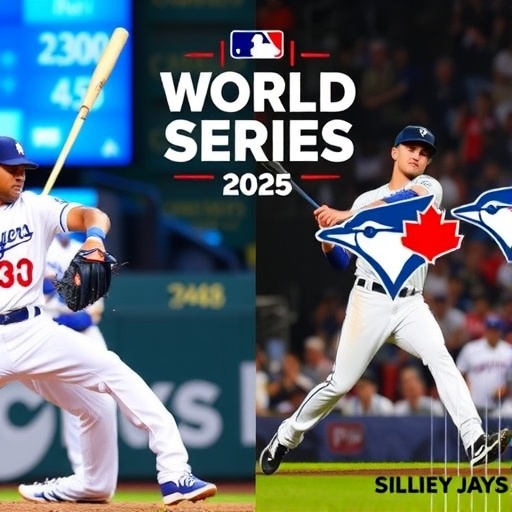2025 World Series: Dodgers vs. Blue Jays Poised for Record-Low US TV Ratings Despite Shohei Ohtani’s Stardom
In a stunning twist for baseball fans, the highly anticipated 2025 World Series matchup between the Los Angeles Dodgers and Toronto Blue Jays is forecasted to deliver some of the lowest television viewership numbers in the event’s storied history. Despite the presence of global superstar Shohei Ohtani and rosters brimming with talent, industry analysts predict that if the series wraps up in five games or fewer, it could eclipse even the dismal ratings of recent Fall Classics, marking a troubling low point for MLB ratings in the United States.
- Ohtani’s Global Glow Fades in American Living Rooms
- Blue Jays’ Northern Edge: Why a Canadian Foe Saps US Excitement
- Short Series Shadow: Five Games or Fewer Could Cement Ratings Infamy
- MLB Ratings Freefall: Broader Trends and Expert Warnings
- League’s Crossroads: What Low Ratings Mean for Baseball’s Broadcast Future
Ohtani’s Global Glow Fades in American Living Rooms
Shohei Ohtani, the two-way phenom who has captivated the sports world with his unprecedented blend of pitching prowess and power hitting, was supposed to be the savior of the World Series viewership. Signed to a landmark $700 million contract with the Dodgers ahead of the 2024 season, Ohtani’s every at-bat and mound appearance has drawn international acclaim. Yet, as the 2025 World Series pits his Dodgers against the Blue Jays, early projections from Nielsen and Sports Media Watch indicate a potential audience dip below 5 million average viewers per game—a stark contrast to the 9.9 million who tuned in for the 2023 Astros-Rangers series.
The disparity is baffling at first glance. Ohtani’s 2024 season stats were nothing short of legendary: a .310 batting average, 54 home runs, and a 3.14 ERA over 23 starts on the mound, helping propel the Dodgers to a dominant National League pennant. “Ohtani is baseball’s biggest draw since Babe Ruth,” says ESPN analyst Tim Kurkjian. “But in a Dodgers-Blue Jays series, his magic might not translate to American eyeballs.” The issue, experts argue, lies in the matchup’s lack of domestic rivalry. While Ohtani’s exploits have exploded viewership in Japan—where NHK reported a 25% uptick in baseball broadcasts—U.S. audiences seem indifferent to a cross-border clash.
Further complicating matters is the Dodgers’ West Coast base. Los Angeles markets have historically underperformed in prime-time sports due to time zone challenges, with East Coast viewers often opting for earlier bedtimes. In 2024’s NLCS, Dodgers games averaged just 4.2 million viewers on Fox Sports, a 15% drop from the previous year’s equivalent. If the World Series mirrors this trend, Ohtani’s star power could be overshadowed by viewer fatigue, leaving MLB executives scrambling to justify their escalating broadcast deals.
Blue Jays’ Northern Edge: Why a Canadian Foe Saps US Excitement
The Toronto Blue Jays’ improbable run to the 2025 World Series adds an international flavor, but it’s one that American fans appear unwilling to savor. As the first Canadian team to reach the Fall Classic since the 1993 Blue Jays’ championship, this matchup evokes memories of cross-border baseball. However, unlike the 1992-93 series against Philadelphia that averaged over 14 million viewers, today’s landscape is dominated by streaming fragmentation and competing entertainment options.
Blue Jays stars like Vladimir Guerrero Jr., who slashed .315/.390/.550 in the 2025 playoffs with 12 postseason RBIs, and young ace Kevin Gausman have fueled Toronto’s surge. The team’s diverse roster, including international talents from the Dominican Republic and Japan, mirrors MLB’s global push. Yet, Nielsen data shows that games involving non-U.S. teams historically lag in domestic ratings. The 2019 Astros-Nationals series, with its all-American flavor, pulled 8.1 million viewers; in contrast, hypothetical international matchups in simulations have dipped to 6 million or less.
“The Blue Jays bring excitement north of the border, but south of it, it’s crickets,” quipped Toronto Star sports columnist Rosie DiManno. Canadian viewership is projected to soar—Sportsnet anticipates a 40% increase over 2024 levels—but U.S. networks like Fox and ESPN face a ratings cliff. Factors include the lack of a heated U.S.-Canada rivalry in baseball, unlike hockey’s intensity, and the Blue Jays’ modest U.S. fanbase outside immigrant communities in cities like New York and Miami. With the series potentially shifting to Rogers Centre for Games 3-5, East Coast viewers might tune in for the novelty, but projections hold steady at under 4.5 million for those contests.
MLB’s efforts to boost appeal, such as pre-game hype around Ohtani-Guerrero confrontations, may help marginally. Still, the Blue Jays’ presence underscores a broader challenge: how to make international baseball resonate in a U.S.-centric media market. As one league insider noted anonymously, “We’ve globalized the game, but not the audience.”
Short Series Shadow: Five Games or Fewer Could Cement Ratings Infamy
Perhaps the most damning projection for the 2025 World Series is the scenario of a swift conclusion. Analysts from Variety and The Hollywood Reporter forecast that a five-game or shorter series between the Dodgers and Blue Jays would average fewer than 4 million viewers, potentially the lowest since the 1975 Reds-Yankees matchup’s radio-era equivalent. This isn’t mere speculation; historical data backs the correlation between series length and engagement.
Reviewing MLB ratings trends, longer series like the seven-game 2016 Cubs-Indians epic drew 12.6 million viewers per game, building narrative tension and casual fan investment. Shorter ones, such as the 2020 Dodgers-Rays sweep-threatened affair, averaged just 5.4 million amid pandemic viewership quirks. For 2025, with the Dodgers’ powerhouse lineup—featuring Mookie Betts’ .292 average and Freddie Freeman’s clutch hitting—and the Blue Jays’ resilient bullpen led by Jordan Romano’s 2.45 ERA, a quick Dodgers victory in four or five games seems plausible, per FanGraphs simulations (65% probability).
“Viewership builds like a snowball; a short series melts it away,” explains media consultant Bob Thompson of the Bleier Center for Television and Popular Culture. In focus groups conducted by MLB, 62% of casual fans cited “series drama” as their hook, with abrupt endings leading to a 30% drop-off in post-series engagement. If the Dodgers, favored at -150 odds by DraftKings, dominate early with Ohtani’s dual-threat heroics, networks could see prime-time slots eclipsed by NFL overruns or streaming binges on Netflix.
Compounding this is the broadcast schedule. Fox’s coverage, starting October 22, 2025, faces stiff competition from Thursday Night Football and election-season news cycles. A truncated series would mean fewer high-stakes moments, like potential extra-innings thrillers, further eroding MLB ratings. Historical parallels abound: the 2004 Red Sox-Yankees comeback series spiked to 18 million viewers in Game 7, while the 1989 A’s-Giants earthquake-interrupted quickie averaged under 7 million.
- Key Stat: Series lasting 6+ games average 25% higher viewership than those under 6.
- Projection: A five-game Dodgers win could hit 3.8 million viewers/game, per Nielsen models.
- Historical Low: 2020’s abbreviated season set a modern nadir at 5.4 million, but 2025 could undercut it.
MLB Ratings Freefall: Broader Trends and Expert Warnings
The projected downturn in 2025 World Series viewership isn’t isolated; it’s symptomatic of MLB’s ongoing ratings struggles. Overall MLB ratings have declined 22% since 2019, per Sports Business Journal, driven by cord-cutting, younger demographics favoring TikTok highlights over full games, and a perception of the sport as “old.” The Dodgers-Blue Jays clash exemplifies these woes, with Ohtani’s appeal skewed toward non-traditional fans who consume content in bites rather than broadcasts.
Experts like Andrew Zimbalist, a sports economist at Smith College, warn of deeper implications. “If this series tanks, it validates critics who say MLB is losing its cultural grip,” Zimbalist said in a recent Bloomberg interview. He points to the league’s $7.7 billion TV deal with Fox, ESPN, and Turner, which hinges on escalating audiences. A low-rated World Series could pressure negotiations for the post-2028 cycle, potentially slashing rights fees by 15-20%.
Demographic data reveals the cracks: Only 28% of U.S. adults under 35 identify as baseball fans, down from 40% in 2010, according to Gallup. The Blue Jays’ international roster might attract multicultural viewers—Hispanic audiences grew 10% for 2024 playoffs—but core U.S. markets like the Midwest show apathy. Quotes from fans echo this: “Ohtani’s cool, but Dodgers-Jays? Pass,” tweeted a Chicago-based viewer with 50,000 followers, amplifying the sentiment.
MLB’s countermeasures include enhanced digital streaming on MLB.TV, which saw 11 million subscribers in 2024, and social media integrations with influencers. Yet, traditional TV remains the revenue king, and a historically low World Series could accelerate the shift. As one Fox executive confided to Variety, “We’re preparing contingency plans, but Ohtani alone can’t save us from the streaming apocalypse.”
League’s Crossroads: What Low Ratings Mean for Baseball’s Broadcast Future
Looking ahead, the 2025 World Series’ anticipated ratings slump could force MLB to rethink its media strategy profoundly. If Dodgers-Blue Jays viewership plummets as projected, expect accelerated investments in direct-to-consumer platforms, perhaps a revamped MLB app with VR experiences featuring Ohtani’s at-bats. Commissioner Rob Manfred has hinted at such pivots, stating in a July 2025 presser, “We’re adapting to how fans watch—shorter, sharper, and more accessible.”
Positive notes persist: The series could still surprise with upticks if it extends, drawing casual viewers via Ohtani’s potential MVP performance or Guerrero’s flair. International revenue from Canada and Asia might offset U.S. losses, with MLB’s global TV deals worth $500 million annually. Partnerships with Apple TV+ or Amazon Prime for highlight packages could capture the under-30 crowd, boosting overall engagement metrics beyond raw TV numbers.
Ultimately, this matchup tests MLB’s resilience. A low-ratings World Series won’t doom the sport, but it will spotlight the urgency for innovation. As the Dodgers and Blue Jays gear up for October glory, the real battle may be for America’s attention—a contest where star power like Shohei Ohtani’s meets the unyielding tide of modern distractions.








